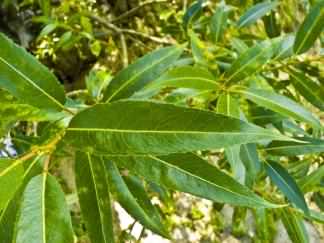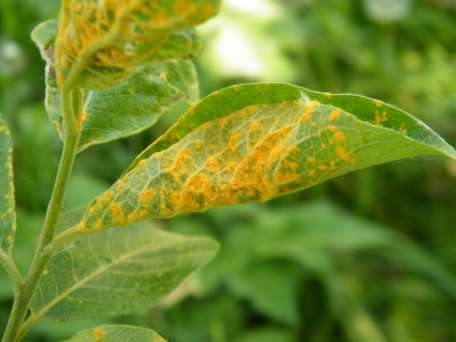
Photo ©2007 Willow
Click any photo for a larger image

Photo ©2007 Willow

Willow Rust - Melampsora spp.
Photo ©2014–

Photo ©2007 Willow
Click any photo for a larger image

Photo ©2007 Willow

Willow Rust - Melampsora spp.
Photo ©2014–
Crack Willow - Salix fragilis
Family - Salicaceae
Also known as - Brittle Willow
Salix fragilis is a medium–sized to large deciduous, which grows rapidly to 10–20m (33–66ft) but can reach a height of 25m (82ft), with a trunk up to 1m (33in) diameter, often multi–trunked, a broad rounded irregular crown which is sometimes pollarded, the trunk often leans. Native trees are found throughout Europe and Western Asia in damp habitats by streams and riversides, in marshes and fens. S. fragilis has become an invasive species in various parts of the world, including New Zealand where it is listed on the National Pest Plant Accord, the United States and South Africa. Twigs are easily snapped and the trunk sometimes cracks open giving the tree its common name, it is highly susceptible to wind, snow damage especially if in full leaf. Broken twigs and branches will take root readily, enabling the species to colonise new areas, it also spreads by root suckers. Ideal for planting on riverbanks and in boggy areas, the dense root system of the Crack Willow helps to prevent erosion.
alternate bright green lanceolate pointed leaves are 10–15cm (4–6in) long, are finely toothed and glossy above, blue–green below. Very finely hairy in the spring becoming hairless later, young shoots have a red–brown tint. Dioecious flowers appear April to May with the leaves, female green, males yellow, both sexes without petals and very small, in long slender catkins 6cm (2.5in) long, they are pollinated by insects. The flowers mature in late spring to fruit capsules which release numerous small cotton–tufted seeds. The bark is dark grey–brown and coarsely fissured in older trees, sometimes confused with White Willow but this has longer leaves and a more open habit. As with Willows in general, the Crack Willow has been pollarded and the cut stems used for baskets and fencing. The leaves are a food source for the Brimstone and Eyed Hawk–moth larvae.
Willows can suffer from quite spectacular rust infections caused by several species of Tree Rust – Melampsora spp. where dusty orange spots or pustules appear on the undersides of the leaves. Severe attacks can leave the leaf virtually covered in pustules, and can be occasionally intermingled with black ones. Rust fungi are biotrophs and as they cannot survive on dead plant material, they must either alternate with a different perennial host including Euonymus (Spindle Tree), Larix (Larch), Ribes (Gooseberry), Saxifraga, or produce resting spores. Tree rusts can also affect Poplar, Willow, Birch and Plum species.
Site design ©1999– Brickfields Country Park - Privacy -